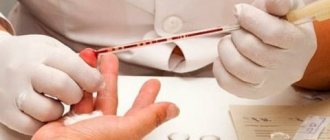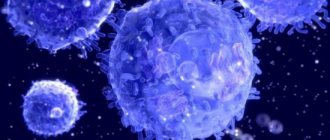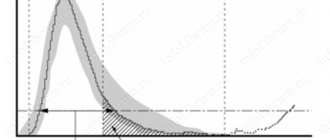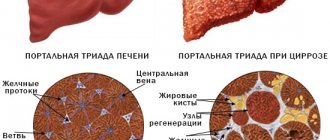0
Author of the article: Marina Dmitrievna
2017.08.21
13 078
Blood analysis
When a foreign agent enters the human body, the immune system launches a defense mechanism. The concentration of specific cells in the blood increases, which are sent to destroy pathogenic microorganisms. If a child has elevated lymphocytes and monocytes, what does this mean?
Functions of blood cells
Monocytes are white blood cells that are found in the blood and then move into tissues where they transform into mature cells. They are sent to places where pathogenic microorganisms actively multiply.
An increase in the number of monocytes indicates that a foreign agent has entered the body. When it penetrates, the immune system rapidly produces cells to destroy the irritant.
Lymphocytes are responsible for ensuring that the immune response starts and stops on time. They identify bacteria and eliminate them, produce immunoglobulins, and remember information about a foreign substance.
Monocytes and lymphocytes are important for the normal functioning of the body. Deviations in their content indicate the presence of pathologies, which helps with diagnosis.
Monocytes and lymphocytes
Lymphocytes and monocytes: briefly about functionality
Inside every person, immunity works like a clock. All formed elements of blood have their own functions and are aimed at destroying any microscopic enemy that penetrates the body or mutated own cells.
The immune response occurs in several ways:
- Phagocytosis . The invading pathogenic microorganism is captured by leukocyte cells and, after absorption, is destroyed with the help of enzymes. The process of phagocytosis is carried out by macrophages maturing from monocytic forms.
- Humoral response . The protective effect comes from antibodies that are produced after contact with certain types of pathogenic microbes. As soon as a foreign agent is introduced, immunocompetent cells identify it and secrete immunoglobulins with destructive properties. The main protective functions are performed by lymphocytic elements.
As you can see, lymphocytes and monocytes are responsible for the destruction of any harmful microbes. Granulocytes also carry out the immune response. In total, there are three main groups of leukocytes that perform the protective functions of the immune system. They not only destroy pathogenic agents, but also remember information about them, forming persistent, in some cases, lifelong immunity.
But in order to understand why leukocytes, lymphocytes and monocytes are elevated, it is necessary to understand their purposes and the reasons for increased production in the bone marrow. An increase in the number of blood cells is always associated with the development of a pathological process or inflammation caused by infectious invasion.
Norm of lymphocytes in the blood
Important!!! In children under one year of age, elevated lymphocytes are not considered a pathological condition. The high rate is observed due to the fact that young children have an immature immune system. It develops over several years, so the level of lymphocytes decreases gradually with age.
In the first days of life, the indicator does not exceed 25%, at the end of the first year it increases and for 4 years remains at a high level - 50-65%. Then the level decreases. By 6 years it is 42%, after 10 years - 40%, by 18 years the norm is established - 37% and does not change in healthy people.
As for monocytes, they change as the child grows:
- The first hours of life - 10%.
- From 5 days to 1 month - 14%.
- 1 month - 12%.
- From one year to 5 years - 10%.
- From 5 to 15 years 4-6%.
- Over 15 years old - 7%.
If the level is elevated, the condition is called monocytosis.
Interpretation of analyzes
The concentration of monocytes and lymphocytes can be determined using a blood test. Since they are types of leukocytes, the indicator is determined as a percentage - their share in the total number of white blood cells.
Norms
The normal level of lymphocytes in the blood of an adult is 19-37% or (1.2-3.0) × 10⁹/l) In a child, depending on age:
- 1 day - from 12 to 36%;
- 1 month - from 40 to 76%;
- 6 months - from 42 to 74%;
- 1 year - from 38 to 72%;
- 1 year-6 years - from 26 to 60%;
- 6-12 years - from 24 to 54%;
- 13-15 years old - from 22 to 50%.
Norms are not influenced by gender or age. The norm for a healthy adult is from 3 to 11%. In units, the norm is: (0.09 - 0.70) × 10⁹/l. Fluctuations within established limits can be influenced by cyclic fluctuations in the intensity of human biological processes and food intake.
A newborn baby has more monocytes in the blood than an adult. This is necessary because during such a period the child especially needs protection from harmful microorganisms while he adapts to the world around him.
The normal range of monocytes is:
- newborns - from 3 to 12%;
- 2 weeks - from 5 to 15%;
- up to a year - from 4 to 10%;
- 1-2 years - from 3 to 10%;
- 2-16 years - from 3 to 9%.
Important information: What does it mean to have an increased hematocrit in a child’s blood?
The weight of these cells varies depending on the number of leukocytes; the gender of the child does not matter. If the level of monocytes is normal, this indicates that dead cells are eliminated on time and there are no harmful microorganisms in the body.
Deviations
If monocytes in the blood of a child or adult are elevated, monocytosis is detected. He can be:
- Relative - the level of monocytes is above 11%.
- Complete - the number of cells exceeds 0.70 × 10⁹/l.
Possible reasons that monocytes are elevated in an adult:
- inflammatory diseases of acute or chronic course (viral, fungal, bacterial, parasitic);
- conditions after infectious diseases;
- autoimmune pathologies;
- presence of tumors;
- oncohematological processes;
- poisoning with phosphorus, tetrachloroethane.
Complete monocytosis can be caused by the following diseases:
- mononucleosis;
- flu;
- ARVI;
- tuberculosis;
- candidiasis;
- syphilis;
- appendicitis;
- adnexitis;
- rheumatoid arthritis.
An increased level of lymphocytes in the blood is called lymphocytosis. An increase in leukocytes in the analysis should not be alarming if:
- this was preceded by hard work, active recreation on the beach;
- if the tests were taken during or immediately after menstruation;
- during pregnancy.
Therapists consider the parameters of the leukocyte series in a comprehensive manner. When the number of both lymphocytes and monocytes is increased, this is a consequence of pathology. It is impossible to make an accurate diagnosis based on one study. Any changes in the blood test should be perceived as an additional symptom of the disease, which is taken into account when differential diagnosis is performed.
Simultaneous cell enhancement
Monocytes and lymphocytes are two types of white blood cells that determine the functioning of the immune system. If their level increases, this indicates that the immune system is fighting pathogenic microflora in an enhanced manner. The child’s defense mechanism works properly and clearly reacts to foreign agents.
When the level of lymphocytes and monocytes is increased in a child during the period of recovery from an infectious pathology, the disease has receded. This deviation from the norm is positive. It is also observed after surgery.
If two indicators increase during a viral pathology, then a bacterial infection may occur. The doctor checks the injection sites, examines the child’s body looking for redness, diaper rash, and purulent processes in the throat.
Low levels of indicators are observed in some diseases. Lymphocytes are reduced and monocytes are increased during inflammatory processes in the body. In this case, the doctor takes into account other research indicators, complaints and symptoms of the disease.

A child has a cold
Changes in the number of monocytes and neutrophils
If monocytes and neutrophils are increased in the blood (monocytosis and neutrophilia), this indicates increased activity of the immune system, responding to the occurrence of a causative agent of any disease.
The main reasons for this phenomenon include the following factors:
- Any acute viral infections, which include ARVI, influenza, mononucleosis. It is important to know that monocytosis can occur not only with the development of the disease in a particular patient, but also during an unfavorable epidemiological situation for these diseases. During this period, the immune system is in a state of “constant combat readiness,” destroying viruses that enter the body and preventing the development of the disease.
- The same applies to bacterial infections (syphilis, tuberculosis). An increase in neutrophils is diagnosed not only after infection, but also with any accidental contact with the source of infection. This is a kind of protective mechanism that allows you to cope with a small amount of the pathogen.
- In the postoperative period. Any surgical intervention is an invasion of foreign bodies into the body, which provokes an increase in monocytes in the blood. First of all, this prevents the occurrence of purulent complications. In addition, monocytosis is responsible for the restoration of the body after surgery by absorbing blood clots and dead cells.
- Severe neutrophilia can also develop in the case of a complex postoperative complication in the form of peritonitis or sepsis.
- Autoimmune diseases. These include lupus erythematosus, rheumatoid polyarthritis and others. A feature of these diseases is the formation of pathological immunoglobulins, which negatively affect the state of the body’s protective functions. The increase in white blood cells is a response to the appearance of these elements that are foreign to it.
- Oncological neoplasms and blood diseases. Any cancer cell is an aggressor for the body, regardless of where it is located. And the first sign of the development of such a disease is the response of the immune system, which is expressed by an increase in the content of monocytes and neutrophils in the blood.
- Helminthic infestations in children. Parasites are organisms that normally should not be in our body. Therefore, their appearance primarily causes an increase in leukocytes in the blood. Neutrophils are responsible for destroying toxins released by worms, and monocytes are responsible for absorbing the decay products of dead parasites.
- Monocytosis can occur as a result of necrotic processes in the body associated with tissue death. This may be a myocardial infarction with severe damage to the heart muscle, the consequences of severe burns, gangrene, peptic ulcers of the stomach and intestines.
- Another reason for the increase in white blood cells can be vaccination, which is the introduction of a weakened pathogen. The reaction of the immune system is expressed by an increase in monocytes and neutrophils, which are responsible for destroying the pathogenic element.
- Another cause of monocytosis can be an allergy, which is formed due to the entry into the body of an antigen that causes a pathological reaction.
A simultaneous increase in neutrophils and monocytes in the blood indicates the response of the immune system to the development of a serious pathology that requires immediate examination. The quantitative ratio of these indicators may indicate the severity of the disease and its stage.
It is advisable to carry out the analysis several times throughout the entire period of illness. This will help track the development of pathology and note how the body responds to treatment. If, despite the course of therapy, test data does not improve, then additional differential diagnosis is necessary with a revision of the course of administered drugs.
Why do monocytes increase?
Monocytes in a child’s blood are slightly elevated if a purulent infection develops or if he is recovering from a cold. This occurs when the baby is teething or when he bumps or gets injured. A slight increase occurs as a hereditary factor.
If the deviation is pronounced, then this indicates the development of pathology. Indeed, in case of illness, the baby’s circulatory system is not able to fight a huge number of harmful microorganisms, so the bone marrow produces a large number of leukocytes.
An increased rate of monocytes is observed in the following conditions:
- Autoimmune disorders. They cause active production of leukocytes, monocytes, neutrophils to ensure stable functioning of the immune system.
- Infectious mononucleosis. It has a negative effect on the tonsils, liver, lymph nodes and spleen, and therefore affects the composition of the blood.
- Malaria. Accompanied by an increased level of monocytes, the level of hemoglobin and red blood cells decreases.
- Leukemia. Monocytes are increased in the monoblastic type of pathology, but this is rare.
- Polycythemia. It affects the bone marrow, so it does not adequately produce all blood cells.
- Parasites. When parasites enter a child’s body, the immune system produces many white blood cells to fight them.
- Congenital syphilis. Transmitted in utero from a sick mother. The pathology causes leukocytosis, but erythropenia is observed.
- Intoxication of the body with chemicals.
Diseases of the digestive organs, fungal infection, endocarditis, sepsis, and surgical treatment can also provoke an increase in the number of monocytes.
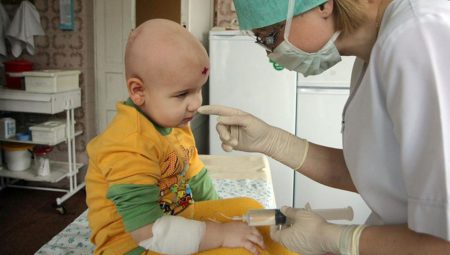
Leukemia in a baby causes an increase in monocytes
Neutrophils and monocytes
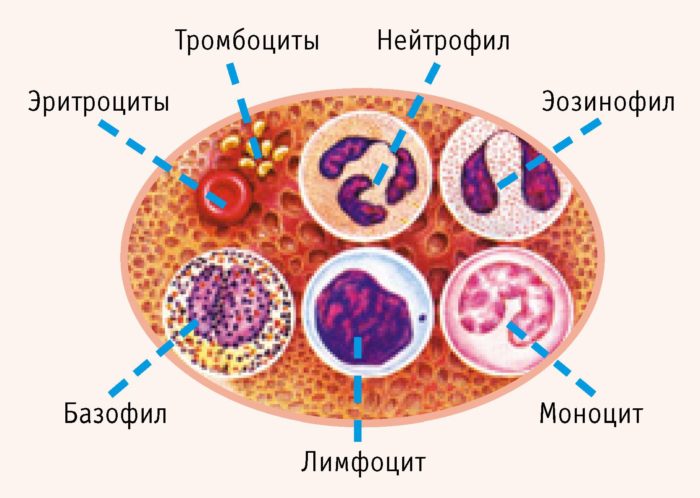
Neutrophils are the main component of the leukocyte formula. Their task is to capture and destroy pathogenic bacteria. Based on the shape of the nucleus, they are divided into two large groups - segmented - these are mature cells, the first to respond to the emergence of pathogenic bacteria. It is their content that increases in the blood at the first signs of the disease.
Bands are immature components of white blood. After the first attack by segmented cells, they continue the immune system response. An increase in their quantitative level is observed at the height of the disease.
The content of band cells in the blood should be approximately constant and not exceed 5% of the total number of leukocytes. The only exception is newborns, in whom this value can reach 12%.
Segmented components of white blood can range from 40-60%, regardless of the age of the subject, except for children in the first month of life, in whom this figure can reach 70%.
Monocytes are one of the components of the immune system, the main task of which is to perform protective functions in the body. This white blood cell prevents various diseases by destroying the pathogen. In addition, monocytes are able to dissolve dead cells and blood clots, preventing the body from being poisoned by the breakdown products of these tissues.
In adults, the percentage of monocytes from the total number of leukocytes should not exceed 8%. In children, this figure can be increased to 11%, which is considered within the acceptable range. The only exception is newborns, in whom the content of monocytes in the blood can reach 15%.
Causes of increased lymphocytes
There is an age-related increase in lymphocytes in the blood of a newborn child, which is due to the fact that the baby’s immune system is just beginning to develop and does not function fully. In this case, no therapy is required. Over time, the indicator will recover on its own. If the content of these cells is higher than the norm that corresponds to a particular age, then there must be a reason for this.
Doctors divide lymphocytosis into malignant and reactive. The first assumes that the concentration of cells increases due to cancer. The second type of pathology is a reaction to the influence of foreign substances and microorganisms that penetrate the internal organs of a person.
The malignant type of lymphocytosis is rarely diagnosed. But it occurs at any age, even in a one-year-old child. But the diagnosis is not made by one blood test. To detect oncology, additional diagnostics are prescribed.
With a malignant increase in cells, a person feels weak, anemia develops, the skin becomes pale, the nose often bleeds, the lymph nodes become enlarged, the temperature rises, pain in the affected area is tormented, and the body is more easily susceptible to infectious pathologies.
Most often, lymphocytes are elevated in children when acute lymphoblastic leukemia develops in the body. This disease causes difficulties in treatment, but if it is detected at the first stage, then there is a chance to eliminate the disease.
All described pathologies are rare. Basically, an increased level of lymphocytes in children indicates that the child has an infectious disease or has recently suffered from it. Such pathologies include:
- Viral: colds, chicken pox, rubella, herpes, hepatitis.
- Bacterial: tuberculosis, brucellosis, syphilis.
- Parasitic: helminthic infestations.
There are factors that can provoke an increase in lymphocytes in the blood of babies:
- Disturbances in the activity of the endocrine system.
- Failure of hormonal balance in the body.
- Autoimmune pathologies.
- Spleen removal surgery.
- Intoxication of the body with heavy metals and chemicals.
- Treatment with certain medications, for example: antibiotics, painkillers, hormonal agents.
- Vitamin deficiency in the body.
- Vaccination.
- Frequent stressful situations.
- Getting injured.
Lymphocytes in children may be elevated due to intense physical activity.
Important!!! The exact cause should be determined by the attending physician. There is no need to make a diagnosis yourself and prescribe treatment for your child. A blood test is an indicator that there are disorders in the body, but cannot indicate the exact cause. To do this, you will need to undergo additional examination.
Decreased cell level
Monocytes and lymphocytes can rise and fall. This deviation also indicates the presence of pathologies in the body or the influence of physiological factors.
As for monocytic cells, their level will decrease in the following cases:
- If bacteria have entered the body and caused the development of severe infectious diseases or sepsis.
- If there are helminthic infestations in the digestive organs. To destroy them, many monocytes are produced, but most die in the process of fighting parasites.
- If a malignant neoplasm develops. In this case, the bone marrow is often affected, which then loses the ability to produce cells. As a result, lymphocytes, monocytes and neutrophils are reduced.
Lymphocytes decrease due to infectious, colds, and inflammatory diseases. Doctors identify provoking pathological conditions: AIDS, hepatitis, tuberculosis, pneumonia, sepsis, lupus, rheumatism, kidney failure, influenza, mononucleosis.
In addition to diseases, a reduced concentration of lymphocytes in a child’s blood is caused by radiation or chemical therapy, or taking certain medications.
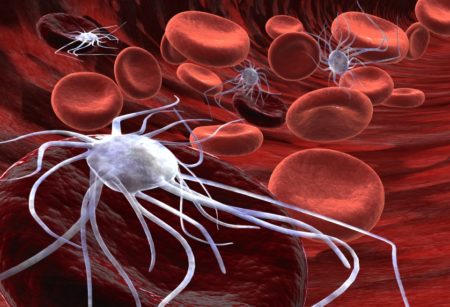
Penetration of bacteria
High levels of leukocyte cells in the blood: how is health assessed?
Doctors look at all parameters of the OBC results, which allows them to determine the development of a particular disease. Sometimes elevated monocytic and lymphocytic body counts may not be dangerous because other values deviate downward. Against the background of reduced numbers of individual formed elements, leukocyte bodies do not cause concern and are within the acceptable norm.
For example, moderate monocytosis in the blood will not be a guide to detect serious infection or malignancy if low levels of lymphocytes and eosinophils are simultaneously observed. Such conditions most likely indicate an allergic reaction or the initial stage of a viral infection (a child is usually diagnosed with measles, chickenpox, and whooping cough).
Why is this happening? Because with the massive death of phagocytic bodies, the bone marrow quickly produces new defenders to compensate. Thus, monocytosis develops. But after 3 days, as soon as the health status begins to stabilize, eosinophils, monocytes and lymphocytes gradually return to normal. Most often, a slight increase in the formed elements involved in phagocytosis at the recovery stage indicates successful treatment and is a positive result.
When a simultaneous increase in monocytic and lymphocytic forms is noted, an acute virus is diagnosed. It could be ARVI, chickenpox, rubella. With monocytosis and lymphocytosis, a decrease in the level of neutrophils is observed. Such numbers usually prompt the doctor to prescribe antiviral drugs.
But the growth of neutrophil bodies with monocytosis, but a drop in the lymphocytic type, is alarming, since this usually happens with a bacterial infection of the body. As a rule, the patient's temperature rises and purulent secretion may be released.
If eosinophils increase along with monocytes, then this phenomenon indicates a parasitic infection (chlamydia, mycoplasma) or the development of allergies.
And when the numbers of three formed elements increase at once - lymphocytes, monocytes and basophils, then a pronounced inflammatory reaction occurs in the body. In this case, it is necessary to exclude the effects of taking hormonal drugs.
It is important to note that all types of microscopic immune defenders are capable of replacing each other and temporarily performing the functions of missing forms. But if a significant deviation of some parameter is observed in the blood test, then additional diagnostics should be carried out to exclude malignant tumors of the hematopoietic system.
How to restore blood cell levels?
In itself, an increase in lymphocytes and monocytes in a child or an adult is not a pathological condition. There are no medications that could bring them back to normal. The indicator can be restored if the cause that caused the deviation is eliminated. As soon as the provoking factor disappears, the cell level normalizes on its own.
Therefore, if the blood cell count is low or high, doctors prescribe additional diagnostics, the purpose of which is to identify the cause of the increase in the number of cells. Based on the examination results, the doctor will make a diagnosis and prescribe appropriate treatment.
